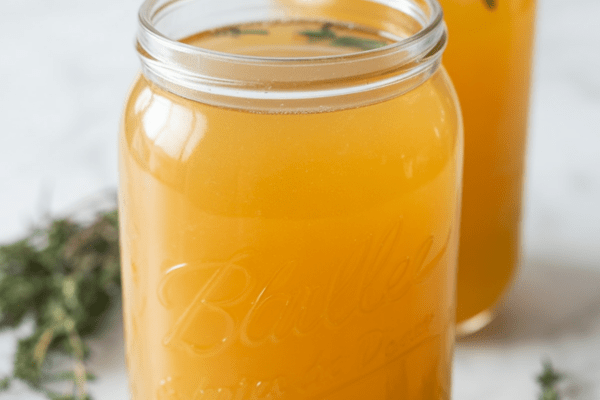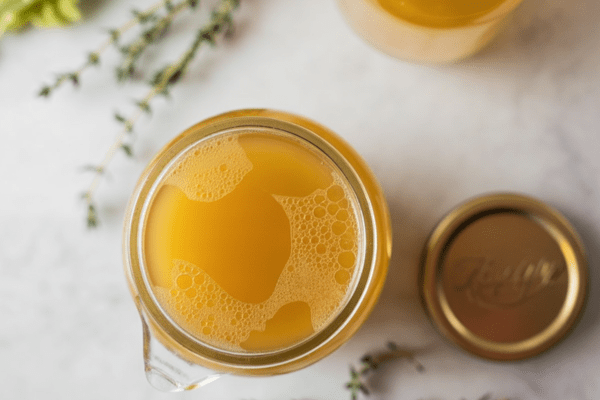I love nothing more than stretching a meal to its full potential. One of the simplest ways I do this is by making homemade broth from the leftover bones of a rotisserie chicken.

It’s such an easy process that turns what most people toss in the trash into a deeply flavorful, low-sodium broth you can use all week. I always say you don’t need to buy expensive bones or specialty broths when you can make your own with what you already have.
If you’re like me and cook often, you know broth is the backbone of good soups, stews, and even rice dishes. Making it at home means I know exactly what goes in—no weird additives or excess salt.
Why I Never Toss the Rotisserie Bones
Whenever we pick up a rotisserie chicken for a quick dinner—say with some roasted veggies and potatoes—I always save the carcass.
Years ago, I used to just throw it away without thinking. One day I realized I was literally tossing money and flavor in the bin.
Now, after carving off the meat for meals like chicken salads or sandwiches, I freeze the bones if I don’t have time to make broth right away.
A homemade broth has such a round, rich taste that boxed broth can’t match. Plus, it’s cheaper. If you use broth as often as I do (for soups, sauces, risotto), this habit pays for itself many times over.
Here’s why I always make this stock:
- So easy – Whether I use the Instant Pot, slow cooker, or stove, it’s no-fuss cooking.
- Flexible – Works in anything from a simple soup to an elegant sauce, or just sipped on its own when I’m feeling under the weather.
- Low sodium – I get to decide how salty it is.
- Gentle – I always keep a jar on hand for days with a queasy stomach or a headache.
- Nutritious – Adds extra protein and nutrients to meals in such a simple way.
My Go-To Tools for Making Broth
I’m a big fan of practical kitchen gear. Nothing fancy or expensive—just what works.
- Instant Pot – Mine is the basic 6-quart model. It’s not flashy, but I use it multiple times a week. It makes broth in about an hour with fantastic flavor. I love that I can set it and forget it.
- Slow Cooker – Great for when I’m going to be home anyway. I set it in the morning and strain it by dinner time.
- Stovetop – Perfect old-school method. I’ll let it simmer on a quiet afternoon while I’m doing other kitchen prep.
- Fine Mesh Strainer – A must. I learned the hard way that nothing ruins broth like bits of bone or mushy veggies left in there.
A little tip: If you’re sensitive to glutamates or tyramine, shorter cook times help. I use the Instant Pot on those days for a cleaner, lighter broth.
My Favorite Ingredients for Broth
One of the best parts about homemade broth is that it’s forgiving. I just use what I have in the fridge.
Here’s what I typically grab:
- Rotisserie Chicken Carcass and Skin – After dinner, I pull off the meat for lunches, then toss the bones and skin in a freezer bag. They freeze beautifully until I’m ready.
- Celery – Adds that classic aromatic base. I don’t worry about pretty chopping—just rough chunks.
- Shallots or Onions – I like shallots for a slightly sweeter, gentler flavor, especially in lighter broths.
- Garlic – Always. It makes everything better.
- Herbs – Rosemary, thyme, and parsley are my usual suspects. Fresh or dried both work fine.
- Filtered Water – Makes for a cleaner, clearer taste.
If I’m feeling creative, I’ll toss in odds and ends like carrot tops or leek greens. It’s a great way to reduce waste and boost flavor.

How I Make Rotisserie Chicken Broth (My Way)
Honestly, I don’t overthink it. The beauty is that it’s so simple, you can do this on autopilot.
In the Instant Pot
I rough chop the veggies so they fit easily. The bones go in first, then the garlic and herbs, then water to the fill line.
Lock the lid, set it to pressure cook for 40 minutes, and let it go. After, I let it naturally release for about 30 minutes.
I always warn friends: watch your hands when releasing pressure. That steam is no joke.
I strain the broth carefully, then let it cool before storing.
In the Slow Cooker
Perfect for lazy days. I just toss everything in, fill with water, and set on high for 4 hours or low for 8.
It fills the house with a savory aroma that makes you hungry even if you weren’t before.
On the Stovetop
I use my big stock pot for this. I bring it to a boil, then reduce to a gentle simmer for 2 to 4 hours. Longer simmering brings deeper flavor.
This is what I do on weekends when I’m puttering in the kitchen, baking bread or prepping for the week.
Making a Heartier Bone Broth
If I want the richer, jiggly kind of bone broth (great for adding body to soups), I’ll do a longer cook in the slow cooker—16 to 18 hours.
But I’ve learned not to overdo it. Once I forgot and went past 24 hours and it turned oddly bitter.
It’s a bit of an art. I find this long slow method is best when I want the added collagen and nutritional benefits, especially in winter when everyone seems to be getting sick.
Storing Your Homemade Broth
I’m a bit of a broth hoarder, I’ll admit it. I always have some on hand.
In the Fridge
I use big mason jars for the fridge. Broth keeps well for 3–5 days. Great for those busy weeknights when you just need to make something comforting fast.
Freezing It
Freezing is my best trick for always having broth.
Here’s what I do:
- Ice Cube Trays – Perfect for small amounts, like deglazing pans or adding to sauces. I measure them out so I know exactly how much I’m using.
- Ziplock or Reusable Bags – For soups and stews. I lay them flat to save space. I double bag to prevent leaks.
One thing I’ve learned the hard way: don’t freeze broth in glass jars. The liquid expands and cracks them. I now stick to plastic containers or silicone trays.
How I Actually Use This Broth
This broth doesn’t just sit around. It’s a real workhorse in my kitchen.
- Soups – Obvious, but so good. Chicken and brown rice soup or green enchilada chicken soup are two I make on repeat.
- Stews and Sauces – Adds depth and richness.
- Cooking Rice or Pasta – A quick way to infuse extra flavor instead of using plain water.
- Sipping on Its Own – On days when I’m under the weather or just need something soothing.
Honestly, it’s one of those small habits that makes you feel like you’re really taking care of yourself and your family.
Rotisserie Chicken Recipes I Make First
I usually get 2-3 meals out of one chicken before even making broth. Here’s how I use the meat:
- Chicken and Brown Rice Soup
- Green Enchilada Chicken Soup
- Chicken Salad for sandwiches
- Buffalo Chicken Egg Rolls for fun appetizer nights
Once the meat is picked clean, the bones are destined for broth. Nothing goes to waste.

Questions I Get About Homemade Broth
Why does my broth look cloudy?
Don’t worry—it’s normal. It often happens if you include the skin or don’t strain well enough. I skim the fat if needed and use a fine mesh strainer for a clearer finish.
Why does it taste bitter?
This usually means it was cooked too long or with too many strong herbs. I try to keep herbs balanced and avoid overcooking.
What’s the difference between stock and broth?
Stock uses bones, so it’s often richer and more flavorful. Broth can be made with just meat. This recipe sort of straddles both.
My bone broth isn’t jiggly—why?
Rotisserie chickens don’t always have enough connective tissue to make super gelatinous broth. For that, I sometimes add extra wings or feet.
I hope you’ll give this a try next time you bring home a rotisserie chicken. It’s one of those humble kitchen habits that feels old-fashioned in the best way—nothing wasted, everything used.
I promise, once you start making your own broth, you’ll never look at store-bought the same way again.
Rotisserie Chicken Broth

This homemade rotisserie chicken broth is the perfect way to get a second life out of your store-bought bird.
Ingredients
- 1 rotisserie chicken carcass (with skin and bones)
- 8–9 cups filtered water
- 2 large carrots, cut into chunks
- 2 celery stalks, chopped into large pieces
- 1 large shallot or leek, halved
- 3 garlic cloves, peeled
- 1 tablespoon whole black peppercorns
- 2 bay leaves
- 3–4 sprigs fresh rosemary
- 2 teaspoons white vinegar
- Kosher salt, to taste
Instructions
- Place the chicken carcass and all the vegetables, herbs, vinegar, and peppercorns into the inner pot. Pour the water over everything until fully covered (but not past the max fill line).
- Secure the lid and set the valve to the sealing position. Select the Pressure Cook or Manual button and set the timer for 40 minutes.
- The pot will take 10–20 minutes to build pressure before the cooking countdown begins. Once it finishes, let the pressure release naturally—this takes about 30 minutes. Then carefully turn the valve to release any remaining steam.
- Remove the inner pot and strain the broth through a fine mesh strainer to remove all solids. Let it cool slightly before transferring to containers.
- Skim off the fat after chilling, if desired. Store in the fridge for up to 5 days, or freeze for longer storage.
Nutrition Information
Yield
4Serving Size
1Amount Per Serving Calories 89Total Fat 3gSaturated Fat 1gTrans Fat 0gUnsaturated Fat 2gCholesterol 26mgSodium 408mgCarbohydrates 10gFiber 3gSugar 3gProtein 7g
All Chicken Recipes.com, occasionally offers nutritional information for recipes contained on this site. This information is provided as a courtesy and is an estimate only. This information comes from online calculators. Although allchickenrecipes.com attempts to provide accurate nutritional information, these figures are only estimates.
